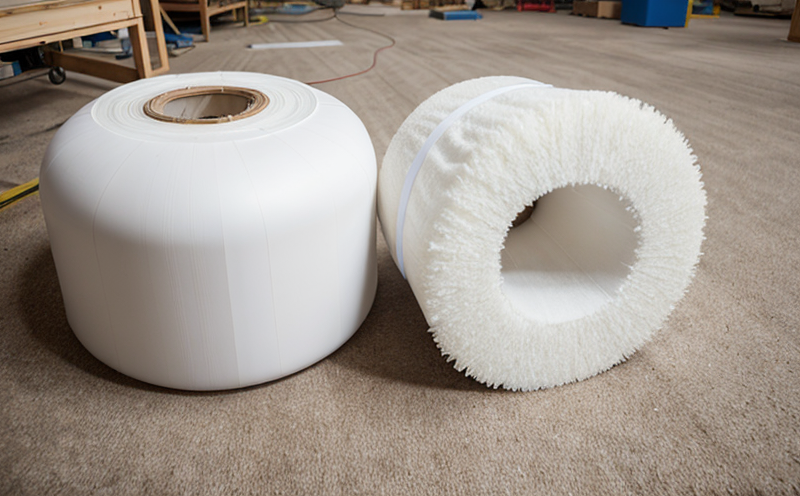ASTM E477 Acoustic Performance of Duct Liner Materials Testing
The ASTM E477 standard is a critical benchmark in the evaluation of acoustic performance for duct liner materials. This test is essential for industries reliant on noise control and air quality, ensuring that materials perform as expected under dynamic conditions within HVAC systems.
Duct liner materials are crucial components in reducing noise propagation through ventilation ducts, improving indoor acoustics, and enhancing overall comfort. The ASTM E477 test measures the acoustic resistance of these materials, which is the ability to reduce sound energy passing through the material at normal operating conditions within HVAC systems.
This test involves simulating actual field conditions by subjecting the duct liner samples to a specified range of frequencies. The testing apparatus includes an acoustic chamber that can precisely control and measure sound pressure levels (SPLs) at different points along the duct. The specimens are installed in a mock-up section of ventilation duct, ensuring realistic performance assessment.
The test setup typically consists of two chambers connected by a straight length of metal duct. The specimen is placed inside this duct to serve as an acoustic barrier. Sound sources and microphones are positioned at both ends of the duct. A noise generator creates sound waves that travel through the duct, encountering the liner material before exiting into the second chamber.
The key performance metric for ASTM E477 is the acoustic resistance coefficient (Rc), which quantifies how effectively a given material reduces sound energy. This parameter is calculated based on the difference in sound pressure levels measured at both ends of the duct. A higher Rc value indicates better noise reduction capabilities, which is critical for applications like commercial buildings, hospitals, and industrial facilities.
Accurate specimen preparation is crucial to ASTM E477 testing. Specimens must be cut from the material under test according to specified dimensions to ensure consistent results. The edges of the specimens should also be smoothed or trimmed to prevent edge effects that could distort measurement data.
The testing process involves several steps, including initial chamber calibration, setting up the specimen within the duct system, and conducting multiple test runs at various frequencies. Each run measures sound pressure levels both before and after the liner material using calibrated microphones placed strategically along the duct. The collected data is then processed to derive Rc values for each frequency range tested.
The results of ASTM E477 testing provide valuable insights into a material’s acoustic resistance, aiding in selecting appropriate materials for specific applications. Compliance with this standard ensures that HVAC systems meet noise control requirements set by building codes and industry standards.
Understanding the implications of ASTM E477 testing is essential for quality managers, compliance officers, R&D engineers, and procurement teams involved in specifying duct liner materials. By ensuring rigorous adherence to this standard, organizations can enhance their products' acoustic performance, contributing to better indoor environments and energy efficiency.
Scope and Methodology
| Testing Parameters | Frequency range: 100 Hz to 4000 Hz |
|---|---|
| Specimen Preparation | Cut specimens to standard dimensions with smooth edges |
| Test Setup | Duct system with two chambers connected by a straight metal duct |
| Sound Source | Noise generator capable of producing sound waves across specified frequency range |
| Measurement Points | Microphones positioned at both ends of the duct to measure sound pressure levels |
The ASTM E477 test involves creating a controlled environment within an acoustic chamber where specimens are exposed to various frequencies. This setup allows for precise measurement of sound pressure levels before and after passing through the liner material. The testing process ensures that results reflect real-world conditions, providing accurate data on acoustic resistance.
Eurolab Advantages
EuroLab offers comprehensive testing services for ASTM E477, leveraging advanced equipment and experienced personnel to deliver precise and reliable results. Our expertise ensures that every test adheres strictly to the standard's requirements.
State-of-the-art acoustic chambers with accurate calibration
Experienced technicians with in-depth knowledge of ASTM E477
Comprehensive testing reports providing detailed insights
Quality and Reliability Assurance
Regular calibration of all test equipment to ensure accuracy
Strict adherence to ASTM E477 guidelines during specimen preparation and testing
EuroLab maintains stringent quality control measures, including regular audits and certifications. These practices guarantee the reliability and consistency of our testing results.





